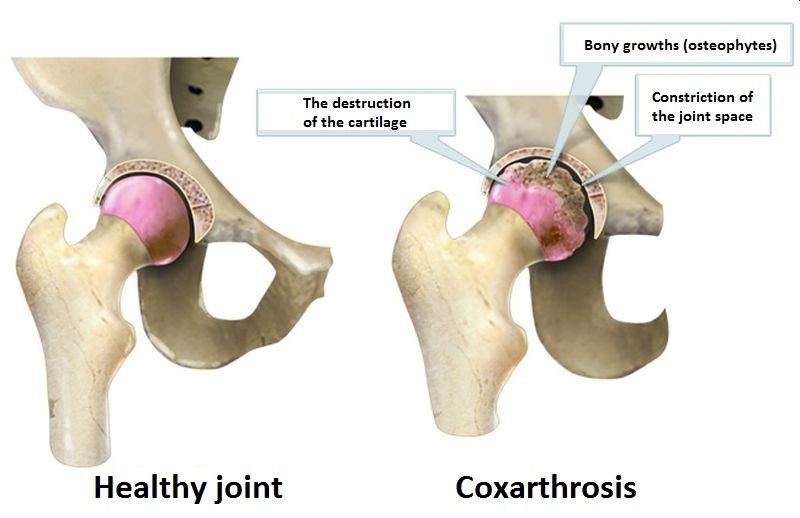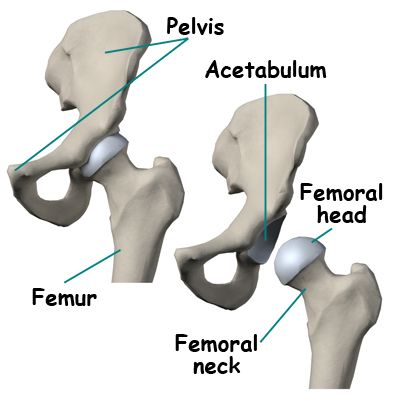Osteoarthritis, or arthritis due to wear and tear, is a common disease that occurs in people mainly middle-aged and elderly. According to rough estimates, in 2011 in the United States 29 million people suffered from this disease. Any joint of the body can be affected, however, the joints that bear the load are most often affected, including hip.
Osteoarthrosis of the hip joint or coxarthrosis in Latin - is characterized by the appearance of pain in the joint and limitation of movements. Patients may find it difficult to cope with everyday activities, such as tilting to tie shoelaces on boots, getting up from a chair, or taking short walks.
Osteoarthrosis progresses with time, so the sooner you start treatment, the less this disease will affect the way you live. There is no radical way to cure osteoarthritis, however, there are many ways to support therapy that will help you cope with pain and remain an active person, says the orthopaedic in Delhi.
HIP ANATOMY
The hip joint is a spherical joint. Its "nest" is called the acetabulum, which is part of the pelvic bone. The second part of the joint is the spherical head of the femur.
The articular surfaces of the bones forming the hip joint are covered with a smooth tissue called articular cartilage. Cartilage provides unobstructed gliding of bones relative to each other.
Inside, the joint cavity is lined with a thin membrane called synovia. In a healthy hip joint, synovia produces a small amount of synovial fluid, which serves as a lubricant for articulating surfaces and improves their mobility.
WHAT IS COXARTHROSIS?
Osteoarthrosis is a degenerative joint disease that most often occurs at the age of 50 years and older, although it can also occur at a younger age, says the orthopaedic in Delhi.
With coxarthrosis, the articular cartilage of the hip joint gradually wears out. At the same time, its surface becomes uneven, it becomes thinner and the distance between the bone surfaces of the articulating bones decreases. As a result, the cartilage wears out completely and the bone surfaces begin to come into contact with each other. In order to somehow compensate for the loss of cartilage, on the periphery of the articular surfaces, the bone begins to grow and forms bone growths - osteophytes.
Coxarthrosis develops slowly and the associated pain syndrome progresses just as slowly.
CAUSES OF COXARTHROSIS
Coxarthrosis does not have any one specific reason, however, there are several factors in which the development of the disease is more likely:
- Age
- Family history of osteoarthritis
- Previous hip injury
- Obesity
- Incorrect formation of the hip joint in the prenatal period - dysplasia of the hip joint
Even if you do not have the risk factors listed above, your likelihood of developing osteoarthritis still exists.
SYMPTOMS OF THE DISEASE
The most common symptom of coxarthrosis is pain. Pain usually develops and progresses slowly, but sometimes a sudden development of pain is possible. Joint pain and stiffness can be most pronounced in the morning, after prolonged sitting or a period of rest. Over time, the pain becomes more frequent, remains at rest and begins to bother the patient at night. Other symptoms include:
- Pain in the groin and thigh radiating to the buttock or knee
- Pain aggravated by intense physical exertion
- Hip stiffness that makes normal walking and joint movement difficult
- Sensation of joint blocking and crunching during movements associated with the presence of free fragments of cartilage and other tissues in the joint that interfere with normal movements.
- Reduced range of motion, affecting the patient’s gait and causing lameness
- Worse pain in rainy cold weather
CONSERVATIVE TREATMENT OF COXARTHROSIS
There is no radical way to cure coxarthrosis, but there are many ways to maintain therapy that can help you cope with pain and remain an active person.
As with degenerative damage to other joints, the initial treatment for coxarthrosis is conservative. The orthopaedic doctor in Delhi can recommend a variety of treatment options.
Lifestyle change. Some changes in your daily lifestyle will help protect your hip joint and slow down the progression of the disease.
- Minimization of those types of activity that increase pain, for example, climbing stairs.
- Replacing high-intensity loads (for example, running and tennis) with less intense ones (swimming and cycling).
- Weight correction, which will reduce the load on the hip joint, thereby reducing the severity of pain and improving its function.
Physiotherapy. It includes special exercises that help increase the range of motion and flexibility of the joint, as well as strengthen the muscles surrounding the joint. The orthopaedic doctor in Delhi and physiotherapist will help you choose the individual exercise program that best suits your needs and lifestyle.
Supporting aids. Using canes, crutches, or walkers will help increase your mobility and make you more independent.
Drug therapy. If the pain interferes with your daily life and you cannot cope with it by other means, the doctor may recommend that you add medications to the treatment.
- Over-the-counter analgesic can effectively help reduce the severity of pain in coxarthrosis. However, like any other drug, it can cause side effects and interact with other drugs that you take. We advise you to discuss possible side effects with your doctor.
- Nonsteroidal anti-inflammatory drugs (NSAIDs) help reduce pain and inflammation, and most of them are also OTC drugs.
- Corticosteroids are powerful anti-inflammatory drugs that can be administered orally or injected directly into the joint.
SURGICAL TREATMENT OF COXARTHROSIS
With severe pain and impaired joint function, when conservative treatment is ineffective, the orthopaedic doctor in Dwarka may recommend surgery.
Osteotomy. The operation consists in crossing the upper end of the femur or acetabulum and reorienting them in order to remove the load from the damaged part of the joint. In the treatment of osteoarthritis of the hip, this operation is rarely used.
Superficial arthroplasty. This operation consists in removing damaged cartilage and bone tissue of the acetabulum and replacing them with an artificial component. At the same time, the femoral head is not removed, and its articular surface is replaced by a smooth metal cap.
Total arthroplasty. This operation involves the complete replacement of the hip joint with artificial metal, plastic or ceramic components.
With total hip replacement in Delhi, the femoral head and acetabulum are replaced by artificial components.
Complications. Complications are possible in any surgical operation, and the orthopaedic surgeon in Delhi will do everything necessary to minimize their risk. The most common complications are:
- Infection
- Excess bleeding
- Thrombosis
- Hip dislocation
- Difference in limb length
- Blood vessel damage
RECOVERY AND REHABILITATION
After any operation on the hip joint, a rehabilitation period follows. The duration of this period depends on the nature of the operation performed.
Your orthopaedic in Delhi may recommend physiotherapy, which will help restore muscle strength and range of motion in the hip joint. After the operation, you will be using a cane, crutches, or walkers for some time.
In most cases, surgery can reduce joint pain and return you to an almost normal daily life.




No comments:
Post a Comment